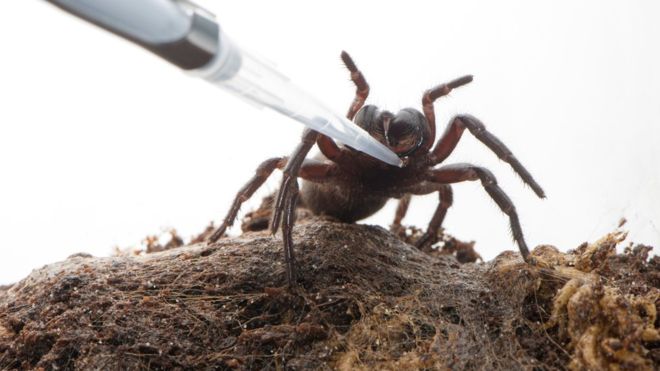2017 has been a tremendous year for breakthroughs in almost all departments of science. Almost every day, a new study or finding is published that could improve health, help understand our past, and change the course of history. We have pulled together three fascinating breakthroughs that appear to be very promising within the scientific community. Each breakthrough could change the way we treat a specific ailment. The first breakthrough we will examine is a fascinating new technology that could change the way we treat severe skin burns. The next breakthrough we discuss is how a venomous spider may provide the very first treatment for brain damage within stroke survivors. The last breakthrough we will include looks at how a certain type of frog mucus may help with efforts to fight the flu.
3 Scientific Breakthroughs of 2017
Spray-on Skin for Burn Victims
Burns on the skin vary in the degree of harshness. Some burns can be treated at home while others require hospitalization and long recovery times. Biomedical scientists have recently constructed a device that can treat severe wounds. At the biotech firm RenovaCare, a new technology has been created that offers hope for skin burn victims. The new device is called the CellMist System. It harvests a burn victim’s stem cells from a one-square-inch patch of unwounded skin and suspends the cells in a water-based solution. The CellMist SkinGun then sprays the stem cell solution onto the burn and new skins starts to grow at a cellular level.
The Food and Drug Administration has not yet approved this revolutionary new product. However, promising experimental treatments have been taking place in Pennsylvania.
The CEO of Renova, Thomas Bold, has reported, “We’ve seen already a couple dozen patients, and we’re very happy about the results”. He also added that while stem cell technology for skin burns currently does exist, SkinGun technology is an improvement on the established stem cell research.
The possible applications of the CellMist System SkinGun could expand beyond just burn victims into other types of skin conditions. However, those usages have not yet been tested.
“Gaining FDA approval is what we are working on right now,” Bold explained.
 Spider Venom That May Halt Stroke Damage
Spider Venom That May Halt Stroke Damage
The deadliest spider in all of Australia can kill a human with one bite within 15 minutes if not treated properly and yet it may hold the world’s first treatment for healing brain damage within stroke victims. Researchers at the University of Queensland and Monash University have found that a protein in the venom of the funnel web spider may change the treatment of stroke victims forever. The protein, known as Hi1a, was injected into rats and found that the protein was “highly neuroprotective”. It blocked ion channels in the brain, which play a critical role in the brain damage of stroke victims. The Hi1a protein protects brain cells affected by stroke even when given up to 8 hours after the event of the stroke.
Stroke is the fifth most common cause of death for people in the United States. The majority of strokes are caused by blockage or blood clot in a vessel or artery that supplies oxygen to the brain.
“This world-first discovery will help us provide better outcomes for stroke survivors by limiting the brain damage and disability caused by this devastating injury,” the lead researcher, Glen King, explained, “”Hi1a even provides some protection to the core brain region most affected by oxygen deprivation, which is generally considered unrecoverable due to the rapid cell death caused by stroke.“
This venom has not yet been tested in human trials. However, if human trials are successful, this could make a major impact on the treatment of stroke survivors by being the very first drug that could protect against stroke-induced brain damage.
 Flu-Fighting Frog Mucus
Flu-Fighting Frog Mucus
This amazing discovery comes from an unexpected source. The slime that covers the skin of a frog in Southern India may contribute to the fight against the flu. This slime contains a powerful protein that has proven promising in research led by Joshy Jacob, an associate professor at the Emory University School of Medicine’s microbiology and immunology department. The frog slime or mucus contains an antimicrobial peptide that helps neutralize bacteria, viruses, and fungi. The research conducted at Emory University displayed valuable results in lab mice, but more research is needed in order to understand if it can be effective on humans suffering from the flu.
“We have identified a potentially new treatment for H1N1 human influenza virus, which is a peptide that comes from the skin of a frog from southern India,” said Jacob, “This peptide works by directly killing the virus, and it is specific for all influenza viruses that have a H1 type of hemagglutinin.”
Hemagglutinin is a protein found on the surface of flu viruses. In order for this flu virus to make you sick, the spikes upon the hemagglutinin attach to your cells and infect them.
This protein could lead to a major breakthrough in the treatment of the flu since it attacks the hemagglutinin while other current drugs on the market target different parts of the virus, which have less of an impact.
“It just blows it up. It makes the virus particle fall apart,” Jacob said.
For this study led by Joshy Jacob, 15 different frogs were tested all within the species of Hydrophylax bahuvistara. These frogs are often the size of a tennis ball and are adorned with bright colors. The 15 frogs provided 32 different peptides. Only 4 out of the 32 peptides showed activity against the H1 virus. Yet, out of those 4 only one was non-toxic to humans.
“So, we tested it against viruses that came from the 1930s until the current ones, and it kills all of the H1s. It doesn’t touch H3. It’s very, very specific,” Jacob said.
That data looks fairly firm and the potential of this mucus is abundant. If human trials prove to be successful, this could alter the way we treat the flu forever.


 Spider Venom That May Halt Stroke Damage
Spider Venom That May Halt Stroke Damage Flu-Fighting Frog Mucus
Flu-Fighting Frog Mucus